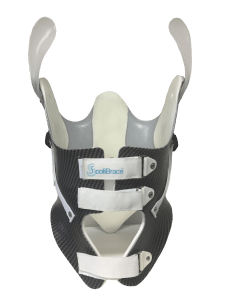Kyphosis is sometimes used to describe a increase in the mid-back curve also known as “hunchback.” This can be confusing as the term “Kyphosis” is also used to describe the normal shape of the mid-back curve
It is normal to have a mid-back kyphosis (backward c-shape curve) at approximately 40 degree’s. When this curve starts to become more pronounced and increased it becomes a problem.
Causes of Kyphosis
Postural Kyphosis is the most common form, it will appear when standing and sitting and disappear when laying face down. It disappears when laying down as the spinal structure is not actually deformed and rigid enabling the muscles to relax and the spine to flatten out. It is common throughout the teenage years when growing and the teenager becomes more aware of their height and is self-conscious.
Scheurmann’s disease results in a increased kyphosis throughout the teenage years whilst growth is occurring. It is a growth plate disorder in the vertebrae causing them to become more wedged and compressed at the front, hence increase kyphosis. This will result in structural deformity as the bone formation is altered. Giving the right treatment at the right time can help to reduce the progression of the deformity. Bracing in the right cases has been shown to be a very effective treatment when combined with specific posture exercises.
Osteoporosis of the spine which involves the vertebrae undergoing compression fractures due to a loss of bone strength. It causes a large increase in the kyphosis in people over 60. It will often continue to progress with age thus it is vital that patients keep their posture upright and keep their bones strong.
Spinal malformations & birth defects can cause the vertebra to not develop properly and may need surgical intervention.
Signs and Symptoms
Typically patients complain of aching and stiffness in their mid-back and lower back. It worsens when weight-bearing, especially when doing activities that require repeated bending such as gardening. Often, teenagers are noticeably hunched from spending hours on their phones, tablet’s or PC’s.
In seniors, it is often noticeable that they become progressively bent forward.
Advanced Treatment Of Kyphosis
In most cases Kyphosis can be treated effectively with specific postural correction exercises & stretches, postural traction and bracing when necessary. Only in severe cases is surgery required due to risk of progression and further complications.
Scheurmann’s disease can often be treated with either postural corrective exercise and a Kypho-brace when needed. A kypho-brace ensures that the posture stay’s upright and ensures that the thoracic vertebrae have less compressional force placed upon them so they can develop in a more normal manner.
Osteoporotic and Senile kyphosis can often be treated with a part-time kypho-brace which helps to keep posture upright and reduce pain and discomfort that is associated with progressive hunching forward.
